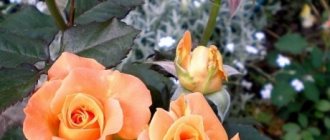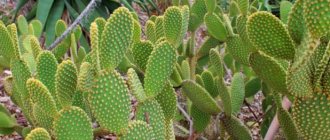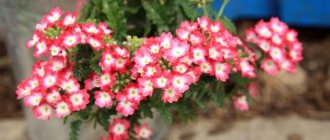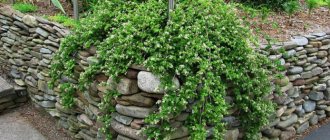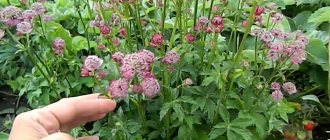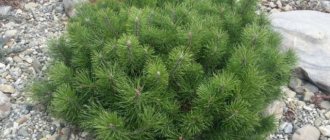Caring for Gymnocalycium at home. Details
Gymnocalycium michanovich.
Photo The task of the gardener is to provide everything that the Gymnocalycium needs: care at home is quite simple if you strictly follow the instructions below.
Blooming Gymnocalycium
When the plant reaches the age of 2 or 3 years, the first flowers appear on it. This is a joyful event for the gardener, since home gymnocalycium blooms very beautifully.
With proper care, flowers can decorate the cactus from April to September.
Different types of this cactus bloom differently: the shade, size and shape of the flower differ.
Temperature
Gymnocalycium at home is quite unpretentious to temperature conditions. The optimal range for it is +200C to +240C, but it also feels good at +150C. The main condition for a cactus is temperature stability. It does not tolerate sudden temperature changes and drafts.
Spraying
This succulent does not care much about humidity levels, so it does not require additional spraying. Regular watering is sufficient for him.
Lighting
Like any other cactus, Gymnocalycium needs intense sunlight, but on the hottest days it can get burned, especially if it is standing on a window facing south.
In autumn and winter it lacks light, although it hibernates. It is recommended to provide additional artificial lighting.
Watering
From March to November, Gymnocalycium needs to be watered regularly, but before that you need to check whether the soil needs additional irrigation.
To do this, you need to dip your finger into the top layer of soil: if it is dry, then it’s time.
Autumn watering is less intense than summer, and as winter approaches, the plant needs to be watered less and less.
Gymnocalycium pot
You need to choose a pot so that it is slightly wider than the root system. Gymnocalycium is comfortable in cramped conditions and blooms well in a small pot.
As it grows, the pots need to be changed, also focusing on the size of the root.
Soil for Gymnocalycium
Gymnocalycium needs slightly acidic, permeable, loose soil. You can purchase ready-made soil, or you can mix leaf, peat, humus and turf soil, add a little coarse sand and perlite to the mixture.
At the bottom of the pot you need to lay a high-quality drainage layer, on top of which you lay out purchased or self-prepared soil.
Feeding and fertilizer
During the flowering period, from March to November, Gymnocalycium needs to be provided with regular feeding. A specialized fertilizer intended for cacti is suitable. Feeding schedule: 2 times a month.
Gymnocalycium transplantation
While the plant is young and growing intensively, it must be replanted every year.
Then its growth slows down and the cactus needs to be replanted in the same pot, but the soil must be completely changed.
This procedure is performed once every 4 years.
Gymnocalycium flower. Description, features, types and care of gymnocalycium
Flowers are an indispensable decoration of our garden plot, house, apartment and any corner. There are a huge number of them. Thousands of different species, subspecies.
The most incredible colors, shapes and sizes. Even half of them are not known to everyone. But I would like to know more about how to coexist with them. Properly breed, care for, and then enjoy the beauty of your creation.
Also, in home floriculture, it is of great importance where and in which corner of the room to place them correctly. What does this or that flower mean? Which positively or negatively affect the atmosphere of each room.
Quite unusual and diverse of them are cactus, gymnocalycium . One of the most numerous species on earth. It has a variety of forms, and the beauty of its flowering will not leave even the most indifferent person to flowers unnoticed.
So what will this green hedgehog Gymnocalycium ? The energetic ability of gymnocacilium helps the development and activity of intellectual abilities. Improves the ability to think logically. It teaches patience and restraint to hot-tempered people. The best place to place a cactus is where a person works mentally.
Also, there is an opinion that a cactus can protect your home from the evil eye and negative impacts on your home. The more thorns, the stronger its energy. Therefore, a room for rest and sleep, or a children's room, is not exactly the place where you need to put a pot with such a flower.
Features of Gymnocalycium
Ripsalidopsis home care
The stem of the Gymnocalycium cactus has the shape of a ball, but it is flattened. The stem can be colored brown, greenish-gray, greenish-brown or gray. The height of the stem is almost half the diameter, which varies from 40 to 150 mm. On the surface of the stem there are 10–32 vertical ribs, on which there are many areoles with bunches of needles, the length of which is 1.3–3.8 cm. In the middle of each areole there are 3–5 straight and long spines, and around them there are radial needles, which are shorter. Flowering is observed from May to November, and bell-shaped flowers are formed on the upper part of the stem; they reach 20–70 mm in diameter, their lanceolate petals are arranged in several rows, and there is no pubescence or needles on the surface of the closed cups. The flowers can be colored crimson, cream, red or yellow. The surface of the ovoid fruit has scales, its length is about 40 mm, and it can be colored purple, green or red.
Thanks to the work of breeders, chlorophyll-free cultivars were born, the stems of which are yellow or red in color. They are cultivated by grafting onto an ordinary green cactus. The Japanese Eiji Watanabe grew the very first hybrid of such a plant with a red stem.
Diseases and pests
How to care for cacti
“Gymnocalyciums” are quite resistant to most diseases, except for root rot, which occurs when the soil is over-moistened.
Pests are infrequently affected: mainly red flat mites and aphids.
Species of the Gymnocalycium cactus are unpretentious and suitable for cultivation in almost any conditions. They will bloom even with minimal attention, making them ideal for new gardeners.
Cactus mix is an unpretentious plant. For modest but conscientious care, the cactus will reward you with beautiful flowering. In today's article we will talk about how to care for this special plant.
Cactus mix, or Dutch cacti - this is not the name of one plant, but a certain category in which the most common succulents are collected, grouped into groups that have different names.
For example, Cactus D5 - these will mainly be cacti of different sizes with white needles, but there are others.
Ferro mix red will delight its owners with large red flowers. The color of the needles of these plants is also red, so they will look very original on your windowsill.
Very interesting representatives of succulents are included in the Cactus mix Indian line group, which presents plants of various shapes and sizes, mainly with white needles.
Similar flowers
- Mammillaria are spherical plants covered with spines. Small flowers are often formed in the axils of the papillae.
- Chamecereus sylvestra is a cactus with luxurious flowers that is found in the mountainous regions of Argentina.
- Rebutia - unites from 40 to 90 species. Originally from South America, Argentina, Peru.
- Notocactus otto is an unpretentious species that blooms lushly under favorable growing conditions.
- Echinopsis is the most popular species for indoor floriculture. The cactus looks like a hedgehog, which is where the name comes from.
Gymnocalycium is an unpretentious plant, the cultivation of which is accessible even to a novice gardener. Some types of cacti can be combined and create a wonderful composition by planting them in one large container. With the right choice of location, temperature and proper lighting, the plant will delight its owners all year round.
If you find an error, please select a piece of text and press Ctrl+Enter.
Cactus Gymnocalycium home care
Bloom
Osteospermum, choose an annual or perennial crop
The first flowers on “Gymnocalycium” appear at 2-3 years of age. With proper care, they bloom in the spring in April and continue to bloom until the end of September.
“Gymnocalyciums,” unlike other succulents, do not need too much sunlight, so they can be placed not only on a windowsill, but also in partial shade.
Some subspecies grow excellently even in heavily shaded places, but in the sun, on the contrary, they burn.
Lighting
Any type of cacti, including Gymnocalycium, requires intense lighting, so the best place for it is a sunny windowsill.
If plants are grown in a window-front greenhouse, in the hottest months they, and especially young plants, should be shaded to prevent them from overheating above 38°C.
Advice: to avoid sunburn, you should not expose them sharply to the sun after wintering.
Temperature
In winter, during the dormant period, the most optimal temperature is 9-14°C, so at this time the plants are placed in unheated rooms on window sills. In frosty weather they are brought home at night.
Help: with the onset of summer, the most comfortable temperature for them will be 20-24°C.
Air humidity
This type of succulent does not require spraying and feels comfortable in both low and high humidity.
However, they are very demanding of fresh air, so in hot weather in the house you should open the windows and slightly ventilate the room in which the gymnocalyciums are located.
Watering
You should not water “Gymnocalyciums” with too hard water: this can lead to stunted growth and even death of the roots.
In winter, during dormancy, watering should be minimal.
In the spring it is increased gradually, as needed.
By the end of summer, watering is gradually reduced again and completely limited by autumn.
In winter, when the plants are completely dry, only slightly moisten them.
Fertilizers
“Gymnocalyciums” are unpretentious and can grow on any earthen substrate. However, to avoid water stagnation, the soil must be loose. It may contain turf, peat or an admixture of sand, expanded clay, charcoal and other loosening components.
Important: when fertilizing, only mineral fertilizers should be introduced: an increased nitrogen content is dangerous for them
You should not overfeed them either: any complex fertilizer should be applied carefully
You should not overfeed them either: any complex fertilizer should be applied carefully
Transfer
Young “Gymnocalyciums” require an annual mandatory transplant. Adult specimens – after 2-3 years.
The roots are carefully cleaned from old soil, which is already depleted. Dead and damaged roots are removed.
The roots and stems can be washed in hot water, then dried thoroughly for 2-3 days and the plant replanted in a shallow pot.
Tip: to protect the stem from wet soil, the top layer of soil is covered with drainage: shards or large stones.
Reproduction
The plant can be propagated either by cuttings or by seeds.
Before planting, the cuttings must be dried.
Large cuttings can take 1-2 weeks to dry. They are planted in a peat substrate.
The seeds of "Gymnocalycium" are planted in the spring. The plantings are covered with polyethylene and placed in a lighted, but not too sunny place.
The ideal temperature for growth is 21°C. Since the film does not allow moisture to evaporate rapidly, watering is carried out only after the soil has dried.
Help: mature plants are transferred to small pots only after six months.
Useful video: caring for the Gymnocalycium cactus
Why is it worth growing Gymnocalycium?
Gymnocalycium amerhauseri species is ready to bloom
Even in the first reference books on cactus growing, they wrote that gymnocalyciums are “unpretentious and bloom tirelessly.” These cacti are suitable for the most inexperienced gardener. They do not require much light, so they can be placed away from the windowsill.
At rest, plants tolerate light frosts without any harmful consequences. Most species even tolerate freezing for a day or more.
Gymnocalyciums are very showy during flowering. They can grow and bloom even without natural light, under lamps, which is often used by collectors who do not have enough space on their windowsills. By the way, there are very few cacti that can be grown without problems under lamps, and Gymnocalycium is a pleasant exception to the rule.
Gymnocalycium blooms are not only easy to achieve, but they are also surprisingly long lasting, can last a week or more.
The flowers close at night and open during the day. A collection of well-chosen species can bloom without interruption for most of the warm season.
Most species are modest in size. The largest ones can grow up to 30 cm wide, but usually adult cacti are an elongated ball no more than 10 cm high.
Gymnocacilium care
Temperature conditions. Gymnocalyciums are completely unpretentious in care. As mentioned earlier, cacti love light, especially in the cold season. But on too hot summer days, the plants need to be shaded.
And there is a lot of fresh air, so rooms with flowers should be well ventilated. The optimal air temperature for cacti is at least ten degrees Celsius
And even if the temperature is cool, it is important that it is uniform, without sudden changes
Watering. In the beginning of spring, plants need to be watered more often. And by summer, the soil is moistened as it dries. The water is slightly acidified, and it is desirable that it be warm, cacti love this. There is no need to spray flowers on hot summer days.
And already in the fall, closer to winter, watering is limited. Since spring, flowers have been fed with purchased fertilizers twice a month. In autumn and winter, Gymnocacilium does not need this.
Growing and care
This cactus requires a competent choice of location to ensure certain lighting and temperature conditions.
Lighting and temperature conditions
Like any representative of exotic flora, this thorn loves light and preferably more , but it is important to shade the window a little, since direct sunlight can burn the delicate skin of the flower. To make it easier to understand how much light you need, you can navigate by the number of spines; the more there are, the more the gymnocalycium consumes solar energy.
You can install a lamp so that it extends the daylight hours and the cactus feels comfortable.
In summer, the plant likes a temperature of +30, by autumn it is advisable to reduce this figure to +20, and in winter to +15 degrees. The thorn has a dormant period when you don’t have to water it at all, lower the temperature to +8 and place it in a minimally lit place.
Humidity and watering
You need to water regularly during the period of growth and flowering - this is summer , by autumn the amount of watering should be reduced, and in winter you should sometimes spray the thorn with a spray bottle. It is advisable to pre-settle water for irrigation (necessarily at room temperature); it should have average hardness values.
The soil should not be moistened too much; it should dry out completely between waterings.
Soil and fertilizer
The soil substrate must be well drained. The composition must contain peat, sand, charcoal and expanded clay (brick chips) . The soil should be neutral or slightly acidic in terms of acidity.
To fertilize, you need to choose a mineral composition of fertilizers that is balanced; you won’t be able to recreate it yourself at home; it’s better to buy ready-made fertilizer at a flower shop. It needs to be applied once a month from spring to autumn; in winter the plant rests. Organic matter should be avoided; it is harmful to the prickly inhabitants of the windowsill.
Transfer
This should be done once every two to three years; it is better to choose a pot diameter slightly larger than the plants. There is a certain algorithm of actions during transplantation, it includes the following:
- the soil is well moistened beforehand;
- remove the stem from it (it is advisable to do this with gloves so that the spines do not damage the skin of your hands);
- clean the roots from dead parts;
- wash the root with warm water;
- dried;
- placed in a moistened soil layer of a new container;
- water with acidified water;
- Place for two weeks in a slightly dark place.
Gymnocalycium Michanovich and its varieties
The star among all the different species is Gymnocalycium Mihanovichii along with Friedrichiae. It was from them that in the forties of the 20th century, colored forms were obtained in Japan, which later became famous throughout the world.
The stem is predominantly ribbed, spherical, wide, often flattened, up to 5 cm high, up to 6 cm in diameter, gray-green, olive or brownish. Ribs 8-10, narrow, triangular in cross-section, with a wavy, pointed edge, and thickened. Radially growing spines up to 1 cm long, grayish, intricately curved. It seems that the ribs are located lengthwise and crosswise.
Some specimens form a large multi-petaled funnel-shaped flower, most often white, with a diameter of 5-7 cm. There are varieties that bloom with pink or yellow flowers.
Diseases and pests
Diseases
Gymnocalycium may suffer from root rot. It occurs due to improper care, namely, due to the use of excessive nutrient substrate or due to too frequent or very abundant watering. As a rule, rot does not appear on the stem, but it can completely destroy the root system of the bush. You can tell that a cactus is sick by the fact that it begins to grow more slowly and stops blooming. If you notice signs of rot, then dig up the plant, cut out all the rotten areas of the roots to healthy tissue. Then the root system should be treated with wood ash, crushed coal or a solution of a fungicidal preparation. After this, leave the cactus outdoors for a while so that it dries well. Then it is placed on the surface of the soil mixture for rooting. To prevent root rot from spreading to the stem, the soil mixture in the pot is covered with a layer of expanded clay.
Pests
In some cases, a dangerous pest such as a spider mite settles on the gymnocalycium. This pest very often settles on all succulents and cacti, and it settles where the air is dry. Most often, pests settle on young bushes, as a result of which rusty, dry spots form on the surface of the stem. If you are growing a small number of cacti, then each of them will need to be washed with slightly hot water, and then the stems will be wiped with a cotton swab dipped in a solution of ethyl alcohol. However, if you have a lot of cacti, then it will be easier to spray them with a solution of an acaricidal drug, for example: Fitoverm, Aktellik, Aktara, etc.
A pest such as a mealybug can settle on the root system of Gymnocalycium. If all the scale insects live underground, then their presence can be noticed by the following signs: lack of flowering, as well as very slow growth. Dig up the bush, free its roots from the substrate and inspect them. If you notice mealybugs on the surface of the roots, then immerse them in slightly hot water for a quarter of an hour; its temperature should be such that your hand can hardly stand it. If you found scale insects only on the root system, then this hot bath will be enough to get rid of them. However, if pests are also present on the stem of the cactus, then it should also be washed with hot water. Instead of such a bath, the plant can be treated with a solution of an insecticidal preparation.
Bloom
Most cacti begin to bloom at 2-3 years , but some species begin to bloom later. From the moment the first bud appears until it withers, 12 days pass.
During the summer, many such cycles occur, until the end of autumn days the plant pleases its owners with its luxurious appearance. In order to maximize the flowering period of the plant, the Gymnocalycium should be provided with sufficient light.
Mixed Gymnocalycium cacti with photo
All types of Gymnocalycium are one of the favorite objects of experimental cactus growers. And if the breeding of hybrid, unusually flowering forms (for example, the long-known red-flowered hybrid of Gymnocalycium denudatum 'Yan Shuba') is of controversial value, then the appearance of “colored” forms of Gymnocalycium-mix is an event not only for cacti growing, but also for all decorative floriculture .
Non-chlorophyll colored forms are known for many groups of cacti, but the first to be introduced into culture were the colored cacti Gymnocalycium-mix (the so-called red caps or neon cacti).
The first to become widespread were red Gymnocalycium mihanovichii (G. mihanovichii) and stenopleurum (C. stenopleurum), and then pink of different shades and purple appeared.
Pay attention to the photo - Mixed Gymnocalyciums can have black and yellow forms:
The variety of colored forms has become so large that specialized collecting is developing. However, the main use of these plants is decorative.
Since achlorophyll-free cacti feed on the rootstock, they themselves need almost nothing - no sun, no special care, no special temperature conditions: if only the rootstock were alive. As a rootstock, you can choose the most resistant cacti. Non-chlorophyll Gymnocalyciums produce a lot of babies, which are very easy - easier than many other cacti - to graft.
Non-chlorophyll Gymnocalyciums can even bloom - not as profusely as their normal relatives, and only in a well-lit place. The decorative value of colored Gymnocalyciums can hardly be overestimated. They can stand anywhere and be a bright spot in any plant composition. However, it should be taken into account that colored forms are short-lived and their collection value is low. A novice collector does not need them.
A novice collector should keep in mind that, on the one hand, when choosing Gymnocalyciums, it is better to prefer “old”, well-known and undemanding species in cultivation.
Eg:
G. baldianum (baldianum) - with red flowers, rare among representatives of the genus.
G. quehlianum (quehlianum) with a brownish flat-spherical stem.
G. bruchii (bruchi) is graceful, bushy, completely covered with short pinkish spines and blooms very early, at the very beginning of spring, with small pink flowers.
G. damsii (damsi) - opens many large white flowers at the same time.
G. mihanovichii (mihanovichi) is beautiful and diverse, with flowers ranging from white to green or yellow in different shapes.
G. denudatum (denudatum) - with a characteristic fleshy spherical stem and spider-like spines.
But, on the other hand, all these species, as a result of long and often illiterate cultivation, are genetically contaminated and usually have no collection value.
As can be seen in the photo, Gymnocalyciums of these species are relatively small, blooming at an early age:
But there are also popular large-stemmed Gymnocalyciums, for which you have to wait for many years to bloom, but they are good even without flowers.
First of all, G. saalionis (saglionis) with large spherical tubercles and powerful curved thorn-like spines, a spectacular plant at any age.
Among the less common and most interesting species are:
G. ragonesii (ragonesi).
G. horstii (horsti).
G. cardenasianum (cardenasianum).
The former has small, flat stems barely rising above the ground, spider-like spines spread across the grey-brown epithelium, and graceful creamy-white flowers appear to be raised high due to a very narrow and long floral tube. The second is unusual for its juicy roundness; its few wide and flat ribs cover slightly curved powerful yellowish spines, but the main thing is its record-breaking white flowers for the genus, up to 11 cm in length and diameter. The third is armed with long, powerful, intricately curved spines, unusually varied in different specimens. The large pink flowers of this Gymnocalycium cannot even always break through the plexus of spines and then do not open.
Here you can see a selection of photos of various types of Gymnocalycium cacti:
Types description with photo
- Gymnocalycium mihanovichii. The stem color is dull or intense green, often turning brownish. Ribs with a sharp and wavy edge, decorated with large areolas.
Light gray long spines are arranged in a radial manner, arching towards the stem. Average number of ribs: 8-10. Flowers with a clearly visible tube: white, yellowish or pale pink.
Photo of Gymnocalycium Mihanovich.
Taking this species as a basis, breeders developed such famous cultivars as a number of Japanese colored cacti Gymnocalycium or the famous “Black Cap” (Gymnocalycium mihanovichii 'Black Cap').
Its dark brown, almost black stem is decorated with white areoles and pink flowers.
Colored cultivars of Gymnocalycium have evenly colored stems of bright yellow, red, purple, and orange colors. These non-chlorophyll forms are grafted onto green cacti, which provide them with full growth and development.
Gymnocalycium baldianum, also known as Gymnocalycium Baldianum (G. baldianum). It is easy to remember by the special shade of the stem - average between blue and green.
The flowers are very beautiful with a rich purple-red color. The plant begins to bloom at an early age. The ribs are separated by transverse grooves. The spines are relatively thin, long, and curved.
Friedrich's Gymnocalycium (G. friedrichii). The stem color is brown with a pink or red tint. Ribs with horizontal stripes, often noticeably lighter or darker than the background.
In cross section, the ribs are very close to triangular. Pink-lilac flowers can be up to 3 cm in diameter.
Gymnocalycium rhodantherum (G. rhodantherum). Other name: G. guanchinense. Comes from Argentina. Known for its long, strong, densely arranged spines.
Light in color, white or beige, these spikes along with the white areoles look very beautiful, although a little scary. Typically, each areola bears 5-7 radiating spines, noticeably curved.
The stem is green, often brownish or with a purple tint. The ribs are wavy. The flowers are large, white, the petals are red or pink at the base. The flowering period of this cactus is from June to mid-autumn.
G. Saglione (G. saglione). Gained fame as one of the largest. The diameter of the spherical stem can reach 30 cm. The ribs are divided into separate tubercles, which is why the cactus resembles a ball assembled from a children's mosaic or construction set.
The spines are long - up to 4 cm, light against the background of the bluish-green stem, often curved. There are from 10 to 15 spines in the nest. Gymnocalycium Salona blooms with white, sometimes pink flowers, the flower tube looks shortened. The fruits are red.
G. Schroeder (G. schroederianum). Numerous ribs, spherical stem. The flowers are white or light cream shades. The floral tube is relatively short.
G. multiflorum (G. multiflorum). The stem is spherical, flattened at the top, green. There are usually 10-15 ribs. Pink flowers are characterized by a relatively short floral tube.
G. humpback (G. gibbosum). Its spherical stem turns into a cylinder as it grows, but very rarely exceeds 20 cm in length. The number of ribs reaches 19. It blooms with white or light pink flowers.
G. naked (G. denudatum). Beautiful glossy dark green stem, 5 to 8 ribs. Its tubercles can take on a pear-shaped form. Light spines are located in bunches, close to the stem. Large flowers are white or light pink.
G. quehlianum. The stem is spherical, bluish-green, and the spines can be white, yellow or brownish. The flowers are white with red bases of the petals, large.
G. tiny (G. parvulum). The spherical stem, usually with 13 ribs, is decorated with large symmetrical areoles with spines of a contrasting light color.
Arranged in the form of rays, 5-7 spines appear pressed against the stem. During flowering, these cacti look especially harmonious and elegant. The flowers are usually white.
G. small-flowered (G. leptanthum). The stem is divided into 8 ribs, areoles with medium-sized radially arranged spines are clearly visible. Long, well-defined floral tube with noticeable scales.
The flowers are large and white. At the base, the petals are often more intensely colored: they can be pink or pale orange.
And here is a video in which you will see another variety of Gymnocalycium.
Often, stores sell mixes of Gymnocalycium cacti (an example of one of the mixes in the photo below).
Variety of species: names and characteristics
- Gymnocalycium Michanovich
It has a flattened stem that is either grayish-green or brownish-reddish in color. Gymnocalycium michanovicha blooms in red, white, pink, yellow or orange flowers.
- Gymnocalycium Friedrich
This cactus is brown, red-brown or lilac-burgundy. It contains the least chlorophyll. The common people call it “Little Red Riding Hood” for its appearance.
- Gymnocalycium japonica
This is a form of Gymnocalycium Friedrich. Due to the complete absence of chlorophyll, the plant has a bright stem color. The most common colors are deep yellow or red. This species is grafted onto any green variety, because it cannot take root in the ground. It turns out a very beautiful mix of bright, rich shades.
- Gymnocalycium Horst
A dark green cactus with a flattened, spherical stem covered with small yellow spines. The cactus has 4-6 rounded ribs. In late spring, hippocalycium blooms with lilac-pink flowers with pink stripes in the center of the petal.
- Gymnocalycium Andre
It is grown in groups. The cactus does not like abundant watering and excess light. Its flowers form bushes of many bright yellow heads.
- Gymnocalycium baldianum (or Balda)
Begins to bloom earlier than other varieties. Already in early summer, purple flowers will appear. And the stem of Gymnocalycium baldiamum is gray-green with a blue tint.
- Gymnocalycium naked (naked)
Shiny green stem with few spines. Approximately 8 cm in height.
- Gymnocalycium humpback (or tuberculate)
Ball-shaped matte green stem. Height 20 cm. Diameter 10 cm. Flowers white, cream or pinkish. Long yellow-brown spines.
- Gymnocalycium tiny
The smallest type. No more than 3 cm in diameter. A very small cactus with white flowers 6 cm long.
Pests and diseases
Some common pests:
- mealybug;
- red spider mite;
- scale insect
Mealybug. White, loose discharge appears, resembling cotton wool.
Red spider mite. They notice the appearance of a web; the mite itself looks like small red dots on the stem.
Scale insects - this pest can be seen with the naked eye. It feeds on cactus juice.
The most common disease is stem rot, which appears as soft brownish spots, most often on the lower half of the stem. Damage must be removed to healthy tissue and disinfected.
In each individual case, insecticides can be used, but there are effective “home” or “folk” methods of treatment.
Care and maintenance
Temperature in summer 20-24 Temperature in winter 9-12
Lighting: bright light.
Watering: In spring, watering is gradually increased; during the period from late spring to late summer, the watering regime is the same as for other indoor plants, i.e., as needed, preferably with warm water. From the end of summer, watering is reduced and from mid-autumn it is sharply limited - watered occasionally and little by little.
Hard water and alkaline substrate lead to stunting and death of roots.
Propagation: For most species, cuttings take root easily in spring or summer. The cuttings are dried for several days (large cuttings will require 1-2 weeks) before planting in a peat-based substrate. Reproduction by seeds is possible at 17-25°C.
Air humidity: Does not require spraying.
Transplantation: Annually at a young age; subsequently as needed in the spring. The new pot should be only slightly larger than the old one. Soil: leaf and turf soil, peat, coarse sand (3:2:2:3) with the addition of charcoal and brick chips. The soil should be slightly acidic, without lime, and should be watered with acidified water.
Pests and diseases:: Mealybugs, spider mites, and scale insects are damaged.
Features of care: Special difficulties:
Wrinkled end of the stem, spots of soft rot at the bottom Cause: Waterlogging of the soil, especially in winter.
Lack of growth Cause: Insufficient watering in summer or waterlogging of the soil in winter.
Cork spots on the surface of the stem Cause: Local pest damage, wound or hypothermia. The cause may also be insufficient watering in summer.
Soft brown spots Cause: Stem rot; Well-growing cacti are rarely affected. Cut out the affected area and disinfect the soil with a carbendazim solution. Improve living conditions.
Elongated, uncharacteristic-shaped stem Cause: Overheating in winter or lack of light in summer.
Planting and propagation of gymnocacilium
The important thing you need to know about this flower is that it is a very sun-loving plant. In winter, cacti hibernate and gain strength at the time of growth and flowering. With the arrival of spring, young flowers are replanted every year.
And the older the plant becomes, the less often it requires replanting. Each year, the pot for the planted cactus also needs to be a little larger in size than the previous one.
The most suitable soil for a flower will be purchased, as it contains a small amount of brick or expanded clay chips. Or leaf soil, with sand and peat, with the addition of finely chopped brick and charcoal.
Gymnocalycium is propagated by both cuttings and seeds. At home, Gymnocalycium layerings should be carefully separated from the base of the stem.
If there are no roots on them, then they can be easily removed from the flower by slightly twisting them with your fingers. On some types of cacti, only a certain number of children grow. Therefore, when removing offspring, there is no need to completely peel off the entire trunk, so as not to spoil its aesthetic appearance.
And there are varieties of plants where so many cuttings grow that they begin to inhibit the development and flowering of the cactus. Here you need to thin out the offspring.
After separating the babies from the mother flower, they leave them alone for a day, placing them in a dry place. On the second day, the shoot is placed in moist soil until roots appear. As soon as they have sprouted, and this happens quite quickly, they are planted in a prepared container. Children with already grown roots are immediately seated in their permanent place of residence, in their own pot.
But not all types of Gymnocalycium have processes. Therefore, the rest reproduce by seeds. Plants grown from seeds are healthier and stronger. Although this method is more complicated and requires more time and labor.
Place the seeds in a container with specially prepared soil for cacti. During the day, using a sprayer, you need to maintain low humidity.
The air temperature in the room should be at least 20 degrees Celsius. We are waiting for the offspring to appear. This method of propagation is used at any time of the year. But, young seedlings must be well provided with heat and light.
Cactus grafting at home
Sometimes chlorophyll-free cacti grow on their own, for example, when sowing seeds. You can immediately recognize them by the shoots - yellow or red, sometimes partially spotted. Typically, such cacti die a month or two after germination. There is only one way to save them - vaccination. If Gymnocalycium has grown large shoots, then you can also try to graft them, getting a new plant.
- Prepare the tools: a knife and alcohol to disinfect it; you may also need twine or narrow strips of fabric to secure the scion.
- Cut the top off a green cactus. If the grafted plant is small, then the rootstock must be slightly sharpened, like a pencil, leaving a small flat area at the top.
- The lower part of the grafted cactus needs to be cut off.
- Align the two plants with the cuts and secure them tightly with twine. You can tie the graft crosswise across the bottom of the pot.
- Place the pot in a sunny location, but not in direct sunlight. It is better to maintain the temperature at 18-20˚. Follow the usual watering regime for the rootstock cactus.
- The vaccination should take place in 2-3 weeks.
Reproduction
There are three methods of propagation of this cactus.
Propagation of Gymnocalycium by cuttings
It is not recommended to plant the cutting immediately after it has been cut. First, the cut must dry. Large cuttings usually dry out within 1 or even 2 weeks. Then they are planted in a peat substrate.
Reproduction by layering
The lateral layer of Gymnocalycium is easily separated from the mother plant with fingers or tweezers. After drying, it is placed on a moistened substrate and provided with standard care for cacti. Rooting occurs quite quickly. It happens that the cuttings have already taken root, which are intertwined with the maternal ones. Then you need to dig it up and plant it in a separate pot. Experienced gardeners recommend separating cuttings from the mother plant when replanting.
Propagation by seeds
Seeds are planted in the spring. The container with soil where the seeds are planted must be covered with polyethylene and placed in a well-lit room, out of direct sunlight.
Home care
Let's figure out how to properly care for planted mix cacti at home.
Temperature
In spring and summer, the temperature should be 22-27 degrees. In autumn, the temperature should be gradually lowered to 16-18 degrees.
Watering
For cacti, mixed watering is very important in the summer, since on hot days they need water to cool. Irrigation is carried out every other day using water at room temperature.
. Carry out these activities in the morning or evening.
You cannot overwater the plant, otherwise it will lose turgor.
Light
Mixed cacti love diffused light. They can withstand direct sunlight, but during the day it is better to protect them with curtains.
Trimming
Pruning should be done when the cactus has lost its shape
, its appearance has deteriorated, or it has begun to slowly fade. Procedure:
- Using a sharp knife disinfected with alcohol, cut off the top of the plant.
- To prevent a hollow from appearing when the cut dries, its edges should be slightly sharpened.
- Place the cut top in a container filled ¼ with water. Keep there until roots form at the cut site (about 2 months).
- Plant the young plant in a container with light sandy soil. Place drainage at the bottom of the pot. Within 6 days after planting, the plant can be watered.
Top dressing
It is not recommended to use organic mix for cacti
. The only exceptions are fast-growing species, for which organic compounds must be added in small doses. Mixed cacti need calcium and phosphorus; flowering cacti need potassium most of all. A special nutritional composition intended for cacti and succulents is best suited for plants. You can purchase Cactus fertilizer with a balanced composition of micro- and macroelements.
Transfer
It is necessary to replant mix cacti in the spring, following the following procedure:
- It is not recommended to water the plant 3-4 days before transplanting. This will make it easier to separate the soil from the roots.
- Place a 3-4 cm layer of drainage at the bottom of the container, since stagnation of water is contraindicated for cacti. Fill the drainage holes with shards, and lay crushed stone, expanded clay or coarse sand on top.
- Taking into account the depth of the pot and the length of the root system, place a layer of soil (2-4 cm) on top of the drainage. Place the plant on the ground and straighten the roots. You need to make sure that the base of the cactus is in line with the edge of the container.
- Now you can fill the soil up to the root collar, shaking the container from time to time and compacting the substrate. Place a layer of sand (1 cm) on top of the soil.
- For the first 3-4 days after transplantation, do not water and place the pot with the plant in a place with direct sunlight.
Wintering
In winter, the room must maintain a minimum temperature of 10-12 degrees.
Mix cacti do not like too dry air, so you need to provide them with coolness. You can place the plant on a glazed balcony, but the temperature should not be below 8 degrees.
From November to March, cacti have a dormant period.
. Their moisture requirement is minimal. Water large and old plants once a month, and small ones once every 2-3 weeks. Cacti can be sprayed with warm water.
Reproduction options
Orchid diseases: dark spots and other types of plant diseases and their treatment
It is not difficult to dilute Gymnocalycium at home. The method of propagation depends on the type of cactus.
By shoots
Some species give birth to babies. After flowering, they are separated from the mother plant by simply turning the cuttings around an axis. Next, the following algorithm is followed:
- the baby is kept on the table for several days so that the cut dries;
- Taking a small pot (or plastic cup) with a drainage layer and substrate, the layering is simply laid on top of the soil;
- The soil around the children is moistened.
The transplanted cuttings should be cared for as if they were an adult plant.
Cactus with babies
Note! If it was not planned to propagate the cactus in this way, then when replanting the plant, the children will still have to be removed from the mother stem and placed in separate containers.
Seeds
For those species that do not produce layering, the only reproduction option is by seed. Although flower growers prefer this method for cacti with children. In this case, young plants turn out healthy and strong.
When breeding, adhere to the following recommendations:
- the soil mixture is standard for cacti, but of a smaller fraction;
- the seeds are pre-disinfected with steam or calcined in the oven;
- sow in small containers without burying them in the ground;
- make sure that the soil is always moist (it is recommended to cover the container with film);
- water through a tray or spray the soil from a spray bottle;
- The room temperature is maintained at +20°C and good lighting is provided.
Seed propagation
You can sow cacti at any time of the year. With proper care, seedlings will appear quickly and begin to actively develop. After 12 months they can be planted in permanent pots.
Cactus gymnocalycium
The genus Gymnocalycium belongs to the large cactus family. According to various sources, it combines from 50 to 160 species. The usual environment for thorns is rocky highlands; some cacti climb to a height of up to 2000 meters above sea level; they thrive on well-drained poor soils, hiding from the midday sun in the shade of mountain vegetation. The habitat of cacti is South America, namely Argentina, Paraguay, Uruguay, Bolivia, Brazil. Complete classification of desert and mountain cacti.
photo by the author
The name Gymnocalycium cactus comes from a combination of the Greek words “naked” and “tube”, which reflects its characteristic feature - a long, hairless floral tube. This sets them apart from their relatives, because almost all cacti have fluffy hair.
How diverse are the habitats of thorns, and they themselves are also different in nature! About 15 species are successfully cultivated in indoor floriculture; all Gymnocalyciums are easy to care for and bloom regularly at home, which attracts flower growers.
Gymnocalycium baldianum is a round dark green ball about 10 cm in diameter, covered with hooked radial spines. Its flowers are up to 5 cm in size and have a wide range of shades.
g. baldianum
The naked gymnocalycium (Gymnocalycium denudatum) is distinguished by its originality. This glossy, dark green species has almost no spines. Huge flower tubes, almost the size of the cactus itself, emerge from the center.
g. denudatum
Gymnocalycium erinaceum can have gray, brown, bluish shades. Its body is covered with many spines, and its name comes from the Greek “erinaceum” - hedgehog-spiny. The flowers are usually white and up to 5 cm in diameter.
erinaсeum
Gymnocalycium gibbosum, perhaps the only one of its kind, has a cylindrical trunk shape. It acquires it with age, growing up to 50 cm, having a diameter of about 20 cm.
gibbosum
Gymnocalycium anisitsii is a very miniature succulent. On each tubercle there is a bunch of spines curved in all directions; the flowers are white, up to 5 cm in diameter.
g. anisitsii
The bright red Gymnocalycium carminanthum is similar to it. It itself is about 10 cm in diameter, but is strewn with dense, terrifying spines.
g. carminanthus
Another unusual Gymnocalycium is Ragonese (Gymnocalycium ragonesei). This baby is only 2.5 cm tall with a stem diameter of 5 cm.
ragonesei
The flowers of Gymnocalycium andreae are particularly notable for their beauty. The stem of the cactus itself looks like a deflated balloon, but its flowers are an unusual shade of pink with a brown edging.
andreae
Star-shaped gymnocalycium (gymnocalycium stellatum) can be dark green or olive, and the flowers are cream on the edges and dark red at the core.
g. stellatum
The famous Gymnocalycium mihanovichii is named after the philanthropist Nikolas Mihanovich, who sponsored the expeditions of the Czech botanist Alberto Fritsch. It was the latter who discovered this strange cactus in Paraguay! It was from the mihanovich cactus that chlorophyll-free forms were obtained.
Mihanovichii
In 2000, an association of gymnocalycium lovers, “Gimnorus”, was formed in Russia.
Care
Gymnocalycium is a beautiful, spectacular and very hardy plant. Like many other cacti, it is native to Africa and South America. Loves arid, warm climates and sun. If there is a lack of sunlight, the plant may get sick, but the scorching sun can cause burns on the delicate stem of an indoor cactus. Choose a bright place with diffused light for your gymnocalycinium, or place it in a shaded, south-facing window.
Temperature and humidity
- Gymnocalycium does not like heat; it stops growing when the temperature is too high.
- In spring and summer, when the plant begins to grow, the most suitable temperature for it will be a warm temperature of 20-25˚.
- In winter, the plant must be kept at a temperature of 10-15˚ to stop the growth of the flower when there is insufficient light on a short winter day, and also to ensure a full period of “rest” for the cactus.
- Gymnocalycium prefers dry air, but from time to time the flower needs to be sprayed or washed in the shower in order to maintain its attractive appearance and clean it from dust. But this must be done during the growth period of the cactus.
- This prickly plant loves fresh air, so you need to ventilate the room in which it is located more often. In summer you can take the cactus to the balcony.
Watering
Gymnocalycium takes well to soft, settled water. In summer, the plant needs abundant watering, but moisture should not stagnate in the pot. To do this you need:
- make drainage in the pot;
- the soil should contain large particles of sand and small stones;
- be sure to drain excess water from the pan after watering;
- Between waterings, the soil in the pot should dry completely.
In the cold season, watering should be reduced to 1-3 times per season.
Fertilizer
Mineral fertilizers are not very useful for Gymnocalycium. But if you want to feed your prickly pet, you can use ready-made fertilizer for cacti, which is sold in the store. It is necessary to dilute the fertilizer in a proportion half that indicated in the instructions on the package. Fertilizers need to be applied in spring and summer; in winter, the cactus does not need fertilizing.
Transfer
Gymnocalycium needs to be replanted as it grows. A young plant usually grows faster and therefore needs to be replanted more often than an adult flower. In addition, the plant needs to be replanted if its roots begin to rot. After buying a flower in a store, it is also best to replant it in suitable soil.
Soil for gymnocalycium can be purchased at the store. It loves slightly acidic and neutral soil. Therefore, it will suit the soil for desert cacti or succulents.
You can prepare the soil mixture yourself by taking:
- leaf humus (2 parts);
- peat (0.5 parts);
- turf soil (1 part);
- sand, perlite, small pebbles (0.5 parts);
- charcoal (2-3 tablespoons per pot).
Transplantation must be carried out in spring or summer. If your plant is blooming or is about to bloom, then replanting should be postponed and done later - after the flowers have dried.
The new pot should have drainage holes and not be too deep. You can fill it one-third with fine expanded clay to ensure the drainage of excess water.
When replanting to change the soil, you need to carefully remove the old soil, trying not to damage the large roots. Break the dry earthen ball with your hands; you can use a toothpick to remove soil from the roots.
Transplant the cactus into dry soil. There is no need to deepen the cactus into the soil above the root collar. After transplantation, water after 1-2 weeks.
In case of root diseases, it is necessary to remove damaged root fragments. The wounds can be powdered with ash. The roots must then be dried for several hours and then planted in a pot with dry soil. You can water it a week after transplanting.
Interesting facts about Gymnocalycium
You should place the cactus next to operating electronic devices, then it will help reduce the harmful electromagnetic radiation that comes from them. At the same time, rapid fatigue of the body and eyes in particular will not bother you so much; headaches will become a rarity.
When they talk about the impact of these “holocases” on the energy of the house as a whole, it is necessary to take into account that they help to pick up vibrations of anger, hatred and irritation from the space in which they are located. Cacti try to transform them into emanations that are not harmful to humans. Therefore, with their properties that attract negativism, which is so harmful to the human body, these plants are akin to cats. It is worth diluting Gymnocalycium for people who are prone to sudden outbursts of anger and irritation. At the same time, such a small “gross” becomes like a lightning rod that will take on all the consequences of the negative atmosphere.
